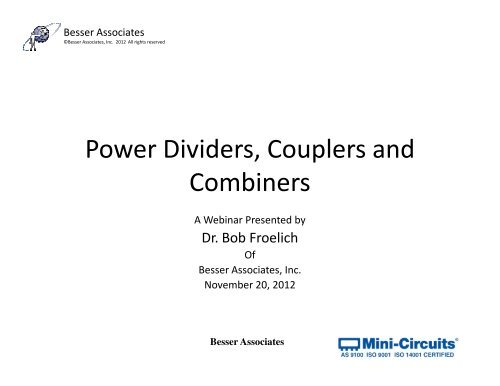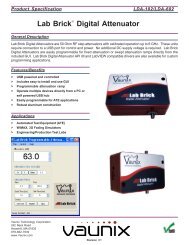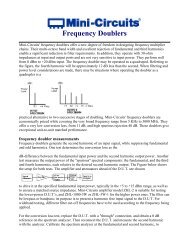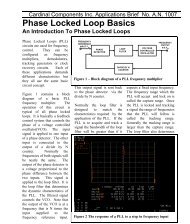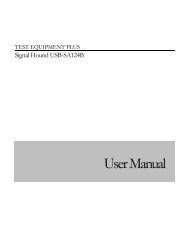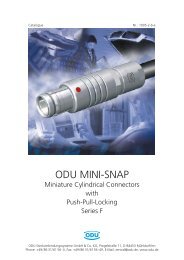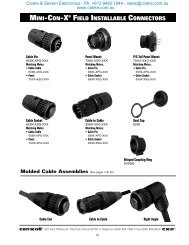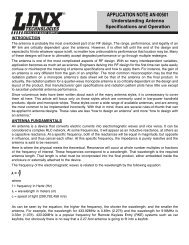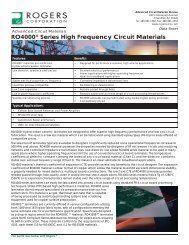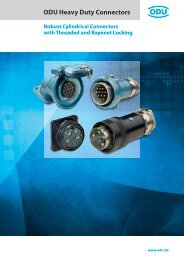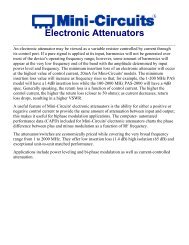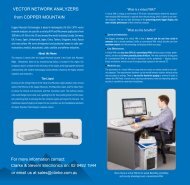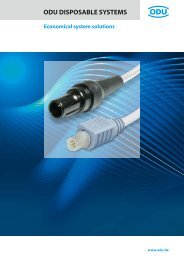Power Dividers, Couplers and Combiners Combiners
Power Dividers, Couplers and Combiners Combiners
Power Dividers, Couplers and Combiners Combiners
You also want an ePaper? Increase the reach of your titles
YUMPU automatically turns print PDFs into web optimized ePapers that Google loves.
Besser Associates<br />
©Besser Associates, Inc. 2012 All rights reserved<br />
<strong>Power</strong> <strong>Dividers</strong>, <strong>Couplers</strong> <strong>and</strong><br />
<strong>Combiners</strong><br />
A Webinar Presented by<br />
Dr. Bob Froelich<br />
Of<br />
Besser Associates, Inc.<br />
November 20, 2012<br />
Besser Associates
Besser Associates<br />
©Besser Associates, Inc. 2012 All rights reserved<br />
Overview<br />
• <strong>Power</strong> dividers, combiners <strong>and</strong> directional<br />
couplers are passive structures that divide RF<br />
input power among several outputs or combine<br />
power from several inputs.<br />
• <strong>Power</strong> <strong>Dividers</strong> <strong>and</strong> <strong>Combiners</strong><br />
– Used to split input power into roughly equal outputs,<br />
or vice-versa.<br />
• Directional <strong>Couplers</strong><br />
– Used to sample a fraction of input power <strong>and</strong>/or to<br />
separate forward <strong>and</strong> reverse traveling waves.<br />
Besser Associates
Besser Associates<br />
©Besser Associates, Inc. 2012 All rights reserved<br />
<strong>Power</strong> <strong>Dividers</strong>/<strong>Combiners</strong><br />
• Goal: Distribute power from one input among<br />
several outputs, or combine power from<br />
several inputs to one output.<br />
• Problems for RF <strong>and</strong> microwave designs<br />
– Impedance match<br />
– Isolation<br />
– Phase relationships among signals<br />
Besser Associates
Transformer <strong>Power</strong> <strong>Dividers</strong><br />
Besser Associates<br />
©Besser Associates, Inc. 2012 All rights reserved<br />
Besser Associates
Adding Isolation: Wilkinson Divider<br />
• When the signals at P2<br />
<strong>and</strong> P3 are the same, the<br />
resistor has no effect.<br />
• When P2 <strong>and</strong> P3 are 180º<br />
out of phase the power is<br />
taken up by the resistor.<br />
• All ports are matched,<br />
<strong>and</strong> P2 <strong>and</strong> P3 are<br />
isolated from each other.<br />
Besser Associates<br />
©Besser Associates, Inc. 2012 All rights reserved<br />
Besser Associates
Besser Associates<br />
©Besser Associates, Inc. 2012 All rights reserved<br />
0<br />
Response of 1GHz Wilkinson Divider<br />
-10<br />
-20<br />
-30<br />
-40<br />
-50<br />
DB(|S(2,1)|)<br />
DB(|S(2,3)|)<br />
DB(|S(2,2)|)<br />
500 1000 1500<br />
Frequency (MHz)<br />
Besser Associates
Besser Associates<br />
©Besser Associates, Inc. 2012 All rights reserved<br />
Unequal <strong>Power</strong> Division is Possible<br />
• Transformed values must combine in parallel to<br />
50Ω.<br />
• <strong>Power</strong> division is inverse to the transformed<br />
impedances.<br />
• Example:<br />
• Transform 50Ω loads at P2 <strong>and</strong> P3 to 150Ω (P2) <strong>and</strong> 75Ω<br />
(P3).<br />
• 1/3 of input power goes to P2 <strong>and</strong> 2/3 to P3.<br />
• But the output voltages at are unequal, so we<br />
can’t add an isolation resistor like before.<br />
Besser Associates
2:1 Divider with Isolation<br />
• An isolation resistor<br />
requires equal voltage on<br />
both sides of the divider.<br />
• Equal voltages with 2:1<br />
power ratio implies 2:1<br />
impedance ratio.<br />
• Transform impedance in<br />
two steps:<br />
– 50Ω (at bottom) to<br />
intermediate levels with 2:1<br />
ratio.<br />
– From there to 75 <strong>and</strong> 150Ω<br />
(at top).<br />
– Resistor value is the sum of<br />
the intermediate impedances.<br />
Besser Associates<br />
©Besser Associates, Inc. 2012 All rights reserved<br />
Besser Associates
0<br />
Response of Uneven Divider<br />
-10<br />
-20<br />
-30<br />
DB(|S(2,1)|)<br />
-40 DB(|S(3,1)|)<br />
-50<br />
-60<br />
DB(|S(3,2)|)<br />
DB(|S(2,2)|)<br />
500 1000 1500<br />
Frequency (MHz)<br />
Besser Associates<br />
©Besser Associates, Inc. 2012 All rights reserved<br />
Besser Associates
N-Way <strong>Power</strong> <strong>Dividers</strong><br />
• One-to-many:<br />
– N outputs can come together<br />
at one input using<br />
transformers that map Zo<br />
loads to N Zo at input.<br />
– If N > 2, it’s impossible to<br />
connect isolation resistors in<br />
a 2-dimensional network.<br />
• Two-Way Steps:<br />
– If N is a power of 2, branch<br />
out with Wilkinson dividers.<br />
– If N is not a power of 2, it still<br />
may be possible to use<br />
unequal 2-way dividers <strong>and</strong><br />
achieve high isolation.<br />
http://www.microwaves101.com/downloads/Robots_versus_Dinos.pdf<br />
Besser Associates<br />
Besser Associates<br />
©Besser Associates, Inc. 2012 All rights reserved
Besser Associates<br />
©Besser Associates, Inc. 2012 All rights reserved<br />
5-Way <strong>Power</strong> Divider<br />
Besser Associates
Besser Associates<br />
©Besser Associates, Inc. 2012 All rights reserved<br />
<strong>Power</strong> <strong>Combiners</strong><br />
• <strong>Power</strong> combiners have N inputs <strong>and</strong> one output.<br />
• Often used to<br />
– Combine the outputs of several amplifiers.<br />
– Combine received signals from several antenna elements.<br />
• Biggest difference is in the power rating of the isolation<br />
resistors.<br />
– <strong>Power</strong> divider: Resistors dissipate power if the loads are<br />
reflective. A low power rating is often ok.<br />
– Combiner: Resistors dissipate power if the sources are not<br />
balanced in magnitude <strong>and</strong> phase. A large power rating is<br />
often required.<br />
Besser Associates
Besser Associates<br />
©Besser Associates, Inc. 2012 All rights reserved<br />
Dividing <strong>and</strong> Combining in a <strong>Power</strong><br />
Amplifier<br />
Besser Associates
Besser Associates<br />
©Besser Associates, Inc. 2012 All rights reserved<br />
Directional <strong>Couplers</strong><br />
• Directional couplers have an arrangement of<br />
two transmission lines so that energy can<br />
“leak” from one line to the other.<br />
• Often used to sample off a small portion of<br />
the signal power.<br />
• <strong>Couplers</strong> have a directional property that is<br />
useful in many measurements.<br />
Besser Associates
Besser Associates<br />
©Besser Associates, Inc. 2012 All rights reserved<br />
Directional <strong>Couplers</strong><br />
•Forward <strong>and</strong> reverse traveling waves can be observed by the use of a directional coupler.<br />
v F v<br />
v R<br />
3 =<br />
K<br />
+<br />
F K R<br />
3 4<br />
R 0 R 0<br />
v R v<br />
v F<br />
4 =<br />
K<br />
+<br />
F K R<br />
R S =R 0<br />
v S<br />
1 2<br />
v R<br />
v F<br />
R L<br />
For ideal case:<br />
K R =∞<br />
v S<br />
R 0<br />
The dual-directional coupler is two directional couplers connected back-to-back to<br />
minimize “leakage” between Ports 3 <strong>and</strong> 4.<br />
FORWARD COUPLING<br />
REFLECTED COUPLING<br />
R 0<br />
R 0 R L<br />
R 0<br />
3<br />
4<br />
R 0<br />
1<br />
IN<br />
2<br />
OUT<br />
©Besser Associates<br />
Generated:11/20/2012<br />
Besser Associates
<strong>Couplers</strong> in Microstrip or Strip Line<br />
• Operating b<strong>and</strong> is<br />
centered where the<br />
sections are 90º long.<br />
• Multi-section coupler<br />
has wider b<strong>and</strong>width.<br />
Besser Associates<br />
©Besser Associates, Inc. 2012 All rights reserved<br />
Besser Associates
Coupler Specifications<br />
• With ports numbered as in<br />
previous slides, coupler<br />
specifications are<br />
– Loss:<br />
input pwr at 1 / output pwr at 2<br />
– Coupling:<br />
input at 1 / output at 3<br />
– Isolation:<br />
input at 1 / output at 4<br />
– Directivity:<br />
Isolation / Coupling<br />
• Usually all four of these are<br />
expressed in dB.<br />
Besser Associates<br />
©Besser Associates, Inc. 2012 All rights reserved<br />
Besser Associates
Besser Associates<br />
©Besser Associates, Inc. 2012 All rights reserved<br />
Measuring Reflections<br />
• Connect an unknown load at port 2 <strong>and</strong> send<br />
0dBm into port 1. Assume low loss.<br />
• A sample of reflected power from port 2 appears<br />
at port 4.<br />
• <strong>Power</strong> of reflection sample:<br />
0dBm – Return Loss – Coupling<br />
• <strong>Power</strong> leaking from 1 to 4:<br />
0dBm – Isolation<br />
• Compare the sample to the leakage:<br />
Sample - Leakage = Directivity – Return Loss<br />
Besser Associates
Besser Associates<br />
©Besser Associates, Inc. 2012 All rights reserved<br />
Network Analyzer System<br />
Besser Associates
Besser Associates<br />
©Besser Associates, Inc. 2012 All rights reserved<br />
Using Phase Relationships<br />
• In many couplers there is a 90º (quadrature)<br />
phase relationship between the through <strong>and</strong><br />
coupled paths.<br />
– “Balanced amplifiers” use 3dB quadrature couplers to<br />
cover up input <strong>and</strong> output mismatch.<br />
• <strong>Power</strong> dividers have definite phase relationships<br />
between the two outputs.<br />
– Usually 0º or 180º.<br />
– Can add a length of line to one side of a divider to<br />
make this 90º, 270º, etc.<br />
– Useful in mixers, phased arrays, etc.<br />
Besser Associates
Besser Associates<br />
©Besser Associates, Inc. 2012 All rights reserved<br />
Using a 3dB Quadrature Coupler<br />
Besser Associates
Other Phase Relationships<br />
• Hybrid ring (“rat race”)<br />
coupler<br />
– Input at P1 divides between<br />
P2 <strong>and</strong> P3 with equal phase.<br />
– Input at P4 divides between<br />
P2 <strong>and</strong> P3 with 180º phase<br />
difference.<br />
– P1 <strong>and</strong> P4 are isolated.<br />
• Branch line coupler<br />
– Line sections are 90º long at<br />
center frequency.<br />
– Input at P1 divides between<br />
P2 <strong>and</strong> P3 with 90º phase<br />
difference.<br />
– Two-section coupler shown.<br />
Besser Associates<br />
©Besser Associates, Inc. 2012 All rights reserved<br />
Besser Associates
<strong>Dividers</strong> <strong>and</strong> <strong>Couplers</strong> Made from<br />
Transformers<br />
• Transformer with<br />
center-tapped<br />
secondary can act as a<br />
180º power divider.<br />
• Cross-coupled<br />
transformers form a<br />
directional coupler.<br />
http://michaelgellis.tripod.com/direct.html<br />
Besser Associates<br />
©Besser Associates, Inc. 2012 All rights reserved<br />
Besser Associates
Besser Associates<br />
©Besser Associates, Inc. 2012 All rights reserved<br />
Thank you for Attending !<br />
For more information on this subject <strong>and</strong> more,<br />
please consider attending a future Besser course.<br />
Please visit www.BesserAssociates.com for our<br />
course schedule or contact us at<br />
info@besserassociates.com<br />
A special thanks is due to today’s sponsor<br />
Mini-Circuits, online at www.minicircuits.com<br />
Besser Associates


